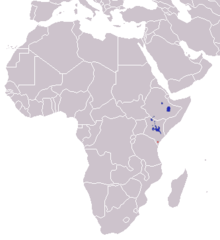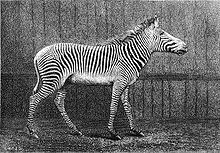The Grévy's zebra lives in semi-arid grasslands where it feeds on grasses, legumes, and browse; it can survive up to five days without water. It differs from the other zebra species in that it does not live in harems and has few long-lasting social bonds. Male territoriality and mother–foal relationships form the basis of the social system of the Grévy's zebra. This zebra is considered to be endangered. Its population has declined from 15,000 to 3,000 since the 1970s. However, as of 2008, the population is stable.
Taxonomy and naming
Description
Detail of head
From left to right: a cranium, a complete skeleton, a left forefoot frontal, and a left forefoot lateral from a Grévy's zebra.
As with all zebra species, the Grevy's zebra's pelage has a black and white striping pattern. The stripes are narrow and close-set, being broader on the neck, and they extend to the hooves.[12] The belly and the area around the base of the tail lack stripes which is unique to the Grevy's zebra. Foals are born with brown and white striping, with the brown stripes darkening as they grow older.[12] Embryological evidence has shown that the zebra's background color is dark and the white is an addition.[3] The stripes of the zebra may serve to make it look bigger than it actually is or disrupt its outline. It appears that a stationary zebra can be inconspicuous at night or in shade.[12] Experiments have suggested that the stripes polarize light in such a way that it discourages biting horse-flies in a manner not shown with other coat patterns.[13] Other studies suggest that, when moving, the stripes may confuse observers, such as mammalian predators and biting insects, via two visual illusions, the wagon wheel effect, where the perceived motion is inverted, and the barber pole illusion, where the perceived motion is in a wrong direction.[14]
Ecology and behavior
Zebra in dense brush
Grévy's zebras rely on grasses, legumes, and browse for nutrition.[12] They commonly browse when grasses are not plentiful.[7][16] Their hindgut fermentation digestive system allows them to subsist on diets of lower nutritional quality than that necessary for ruminant herbivores. Grevy's zebras can survive up to five days without water, but will drink daily when it is plentiful.[17] They often migrate to better watered highlands during the dry season.[7] Females require significantly more water when they are lactating.[18] During droughts, the zebras will dig water holes and defend them.[7] Grévy's zebras are preyed on by lions, hyenas, wild dogs, cheetahs and leopards.[12] In addition, they are susceptible to various gastro-intestinal parasites, notably of the Trichostrongylus genus.[19]
Herd of zebras
Territorial stallions will tolerate other stallions who wander in their territory, however when an estrous female is present the territorial stallion keeps other males at bay.[7][11]:151 Non-territorial males may avoid territorial ones because of harassment.[15] When females are not around, a territorial stallion will seek the company of other stallions. The stallion shows his dominance with an arched neck and a high-stepping gait and the least dominant stallions submit by extending their tail, lowering their heads and nuzzling their superior's chest or groin.[11]:151 The call of the Grévy's zebra has been described as "something like a hippo's grunt combined with a donkey's wheeze".[7] To get rid of flies or parasites, they roll in dust, water or mud or, in the case of flies, twitch their skin. They also rub against trees, rocks and other objects to get rid of irritations like itchy skin, hair or parasites.[12] Although Grévy's zebras do not perform mutual grooming, they do sometimes rub against a conspecific.[12]
Reproduction
Zebra foal resting
Zebra mare near younger zebras
Gestation of the Grévy's zebra normally lasts 390 days,[12] with a single foal being born. A newborn zebra will follow anything that moves, so new mothers prevent other mares from approaching their foals while imprinting their own striping pattern, scent and vocalization on them.[12] Females with young foals may gather into small groups.[18] Mares may leave their foals in "kindergartens" while searching for water.[18] The foals will not hide, so they can be vulnerable to predators.[7] However, kindergartens tend to be protected by an adult, usually a territorial male.[18] A female with a foal stays with one dominant territorial male who has exclusive mating rights to her. While the foal will not likely be his, the stallion will look after it to ensure that the female stays in his territory.[23] To adapt to a semi-arid environment, Grévy's zebra foals have longer nursing intervals and wait until they are three months old before they start drinking water.[18] Although foals became less dependant on their mothers after half a year, associations with them continue for up to three years.[7]
Relationship with humans
Drawing of the zebra given to Jules Grévy and kept at the Ménagerie du Jardin des Plantes in 1882
Status and conservation
Grevy's zebras in Samburu National Reserve
The Grévy's zebra is legally protected in Ethiopia. In Kenya, it is protected by the hunting ban of 1977. In the past, Grévy's zebras were threatened mainly by hunting for their skins which fetched a high price on the world market. However, hunting has declined and the main threat to the zebra is habitat loss and competition with livestock. Cattle gather around watering holes and the Grévy's zebras are fenced from those areas.[24]:17 Community-based conservation efforts have shown to the most effective in preserving Grévy's zebras and their habitat. Less than 0.5% of the range of the Grévy's zebra is in protected areas. In Ethiopia, the protected areas include Alledeghi Wildlife Reserve, Yabelo Wildlife Sanctuary, Borana Controlled Hunting Area and Chalbi Sanctuary. In Kenya, important protected areas include the Buffalo Springs, Samburu and Shaba National Reserves and the private and community land wildlife conservancies in Isiolo, Samburu and the Laikipia Plateau.[2]












No comments:
Post a Comment
Note: Only a member of this blog may post a comment.